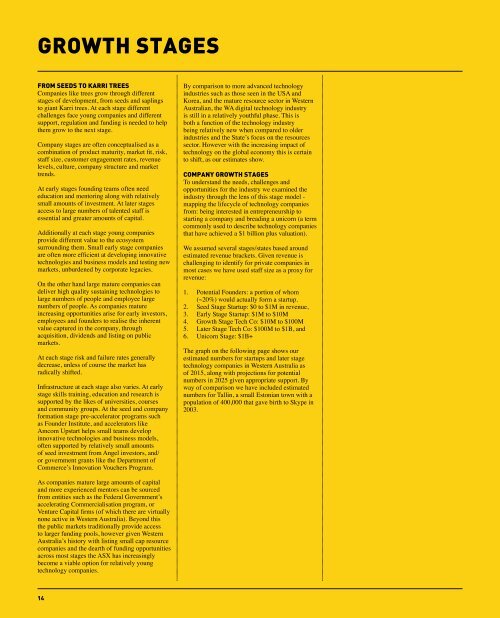STARTUP ECOSYSTEM PRELIMINARY REPORT
ZZm14
ZZm14
Create successful ePaper yourself
Turn your PDF publications into a flip-book with our unique Google optimized e-Paper software.
GROWTH STAGES<br />
FROM SEEDS TO KARRI TREES<br />
Companies like trees grow through different<br />
stages of development, from seeds and saplings<br />
to giant Karri trees. At each stage different<br />
challenges face young companies and different<br />
support, regulation and funding is needed to help<br />
them grow to the next stage.<br />
Company stages are often conceptualised as a<br />
combination of product maturity, market fit, risk,<br />
staff size, customer engagement rates, revenue<br />
levels, culture, company structure and market<br />
trends.<br />
At early stages founding teams often need<br />
education and mentoring along with relatively<br />
small amounts of investment. At later stages<br />
access to large numbers of talented staff is<br />
essential and greater amounts of capital.<br />
Additionally at each stage young companies<br />
provide different value to the ecosystem<br />
surrounding them. Small early stage companies<br />
are often more efficient at developing innovative<br />
technologies and business models and testing new<br />
markets, unburdened by corporate legacies.<br />
On the other hand large mature companies can<br />
deliver high quality sustaining technologies to<br />
large numbers of people and employee large<br />
numbers of people. As companies mature<br />
increasing opportunities arise for early investors,<br />
employees and founders to realise the inherent<br />
value captured in the company, through<br />
acquisition, dividends and listing on public<br />
markets.<br />
At each stage risk and failure rates generally<br />
decrease, unless of course the market has<br />
radically shifted.<br />
Infrastructure at each stage also varies. At early<br />
stage skills training, education and research is<br />
supported by the likes of universities, courses<br />
and community groups. At the seed and company<br />
formation stage pre-accelerator programs such<br />
as Founder Institute, and accelerators like<br />
Amcom Upstart helps small teams develop<br />
innovative technologies and business models,<br />
often supported by relatively small amounts<br />
of seed investment from Angel investors, and/<br />
or government grants like the Department of<br />
Commerce’s Innovation Vouchers Program.<br />
By comparison to more advanced technology<br />
industries such as those seen in the USA and<br />
Korea, and the mature resource sector in Western<br />
Australian, the WA digital technology industry<br />
is still in a relatively youthful phase. This is<br />
both a function of the technology industry<br />
being relatively new when compared to older<br />
industries and the State’s focus on the resources<br />
sector. However with the increasing impact of<br />
technology on the global economy this is certain<br />
to shift, as our estimates show.<br />
COMPANY GROWTH STAGES<br />
To understand the needs, challenges and<br />
opportunities for the industry we examined the<br />
industry through the lens of this stage model -<br />
mapping the lifecycle of technology companies<br />
from: being interested in entrepreneurship to<br />
starting a company and breading a unicorn (a term<br />
commonly used to describe technology companies<br />
that have achieved a $1 billion plus valuation).<br />
We assumed several stages/states based around<br />
estimated revenue brackets. Given revenue is<br />
challenging to identify for private companies in<br />
most cases we have used staff size as a proxy for<br />
revenue:<br />
1. Potential Founders: a portion of whom<br />
(~20%) would actually form a startup.<br />
2. Seed Stage Startup: $0 to $1M in revenue,<br />
3. Early Stage Startup: $1M to $10M<br />
4. Growth Stage Tech Co: $10M to $100M<br />
5. Later Stage Tech Co: $100M to $1B, and<br />
6. Unicorn Stage: $1B+<br />
The graph on the following page shows our<br />
estimated numbers for startups and later stage<br />
technology companies in Western Australia as<br />
of 2015, along with projections for potential<br />
numbers in 2025 given appropriate support. By<br />
way of comparison we have included estimated<br />
numbers for Tallin, a small Estonian town with a<br />
population of 400,000 that gave birth to Skype in<br />
2003.<br />
As companies mature large amounts of capital<br />
and more experienced mentors can be sourced<br />
from entities such as the Federal Government’s<br />
accelerating Commercialisation program, or<br />
Venture Capital firms (of which there are virtually<br />
none active in Western Australia). Beyond this<br />
the public markets traditionally provide access<br />
to larger funding pools, however given Western<br />
Australia’s history with listing small cap resource<br />
companies and the dearth of funding opportunities<br />
across most stages the ASX has increasingly<br />
become a viable option for relatively young<br />
technology companies.<br />
14


